The resurrection of Maestro as a stompbox-building concern has been a real breath of fresh air. With their colorful, substantial enclosures and illuminated bugle logos, Maestro’s five new stomps recall an era when effects pedals were still, thrillingly, working through their infancy. Call them retro if you want, but they look awesome, offer practical functionality, and sound great by just about any measure.
The beauty of Maestro’s stomps runs deeper than cool, colorful enclosures. There are a lot of compelling and often distinctive sounds in these effects. And with the promise of even more new releases before the end of 2022, it’s hard to not be excited about what oddities and original sounds might lie in wait. But for now, these new cornerstone introductions suggest that Maestro is embracing the creative possibilities of an new all-analog pedal line and aiming for sounds and functionality that offer real alternatives on the more accessible side of the cost spectrum.
Maestro's Five New Pedals | First Look
FZ-M Fuzz
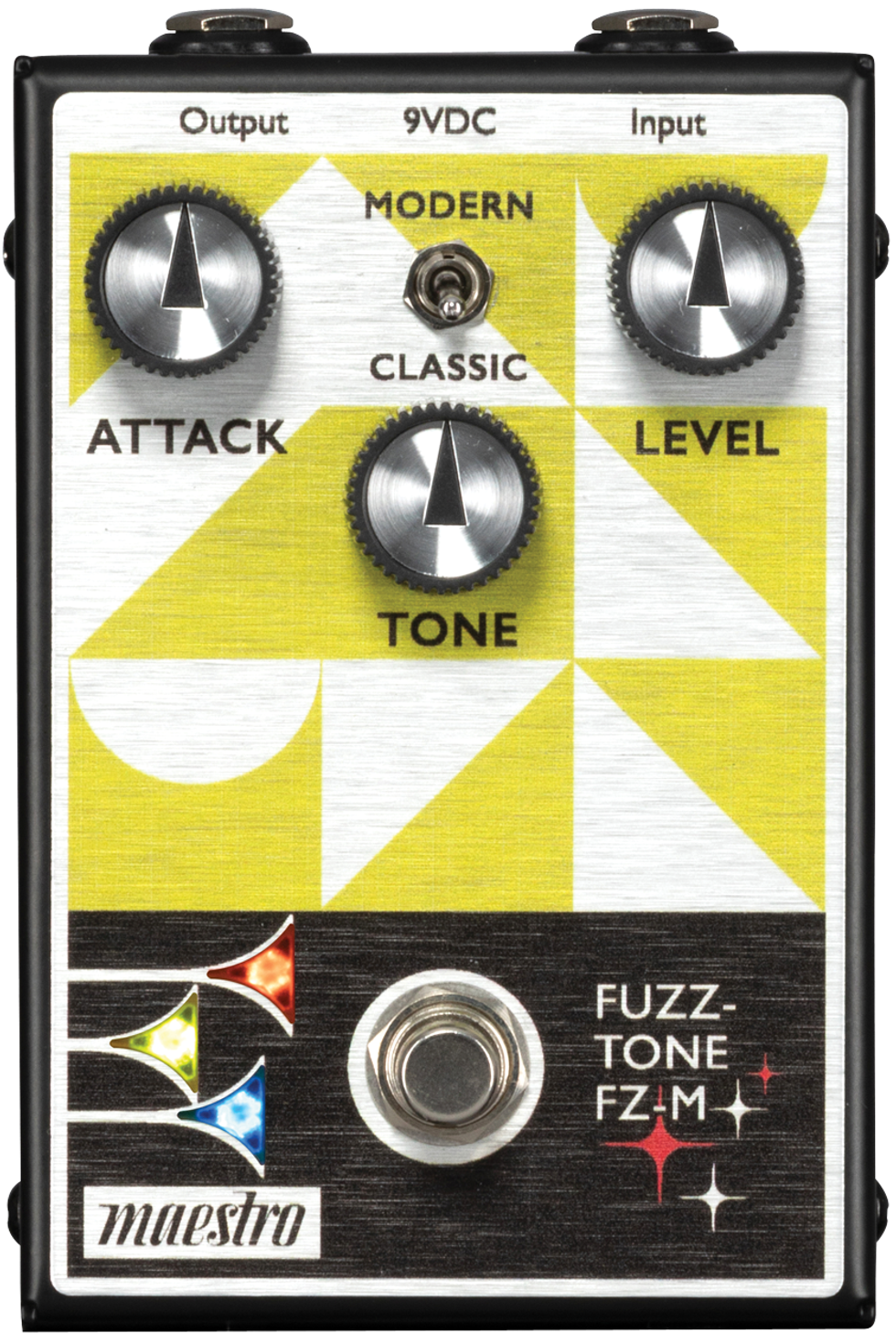
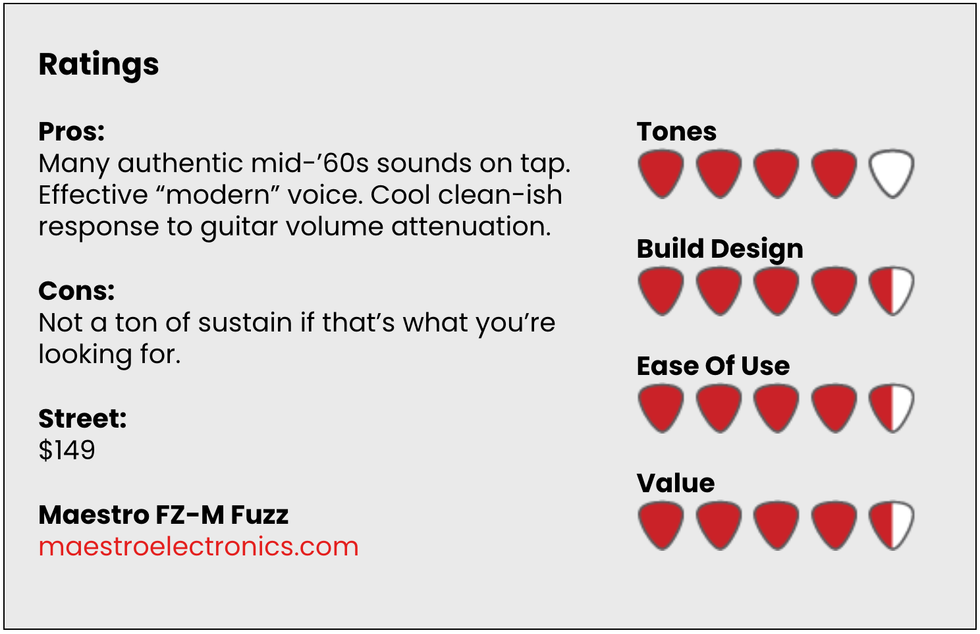
For more information about the Maestro pedal line, go to maestroelectronics.com.
Though much has been made about Maestro’s return to the fuzz space, the new FZ-M is a very different animal than the 3-volt, AA battery-powered FZ-1 that appeared in 1962. Maestro is tight-lipped about the FZ-M’s design particulars. But Craig Hockenberry, director of engineering at Maestro, says the FZ-M employs a six-transistor design. By comparison, the Maestro FZ-1 used just three transistors and an Electro-Harmonix Big Muff used four. Other than the beastly Shin-Ei Super Fuzz, few fuzzes use six.
While the FZ-M is not an FZ-1 reissue, Maestro captures a lot of the sonic essence of mid-’60s fuzzes like the FZ-1 that eludes other builders. In vintage mode, the FZ-M has the snarling top-end focus and rasp that makes mid-’60s fuzzes cut so prominently. There’s more gain and volume than an FZ-1, which makes the FZ-M’s voice more aligned with the silicon Fuzzrite, silicon Bosstone, and, to some extent, the MkIII Tone Bender. (Of the fuzzes I used for comparison, a silicon Fuzzrite was the closest match.) And though the FZ-M is hot in the treble zone, there is a cool high-midrange honk that adds a smooth, almost saxophone-like resonance and complexity that keeps it from sounding too sizzly.
While the FZ-M, with its silicon transistors, is less responsive to guitar volume attenuation than some vintage germanium fuzzes, the FZ-M retains a surprising amount of body and bite without sounding too thin. It can’t match the fuzzy-to-clean dynamic range of, say, a germanium Fuzz Face, but there are still many medium-gain and near-clean tones accessible via your guitar volume knob. The meatier “modern” mode adds midrange to the output that makes chord overtones clearer and tighter. It also adds more of the singing sonorities that increase sustain.
The FZ-M sounds pretty distinctive, which is not easy in a flooded fuzz sphere. Players that value sustain above all things may find the FZ-M lacking compared to something like a Big Muff. But the FZ-M is rich with character, loud, and equally capable of buzzy garage-psych lines and articulate chords, depending on where you set the classic/modern switch. That combination of capabilities is no mean feat, and the FZ-M does it all at a very nice price.
Comet Chorus
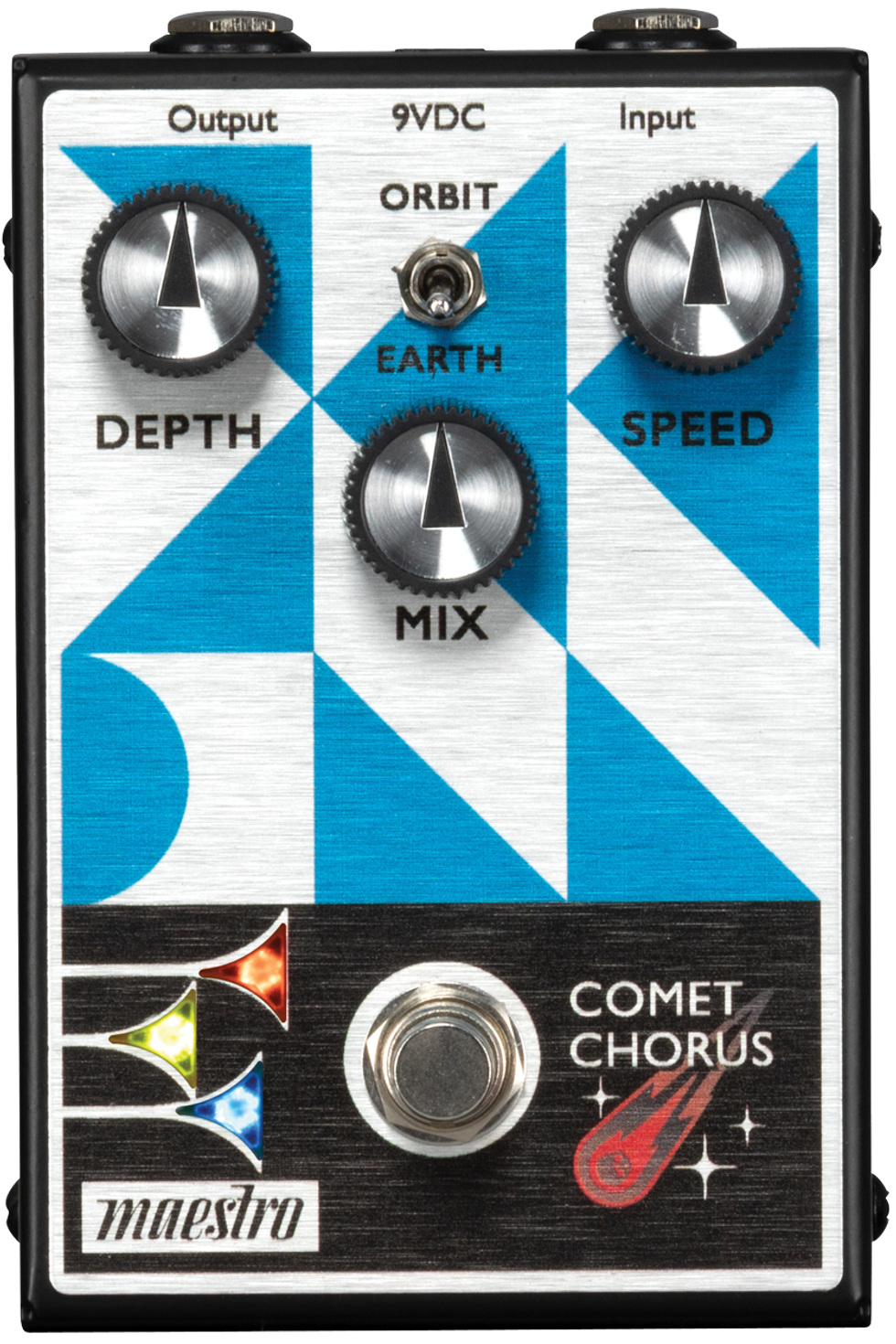
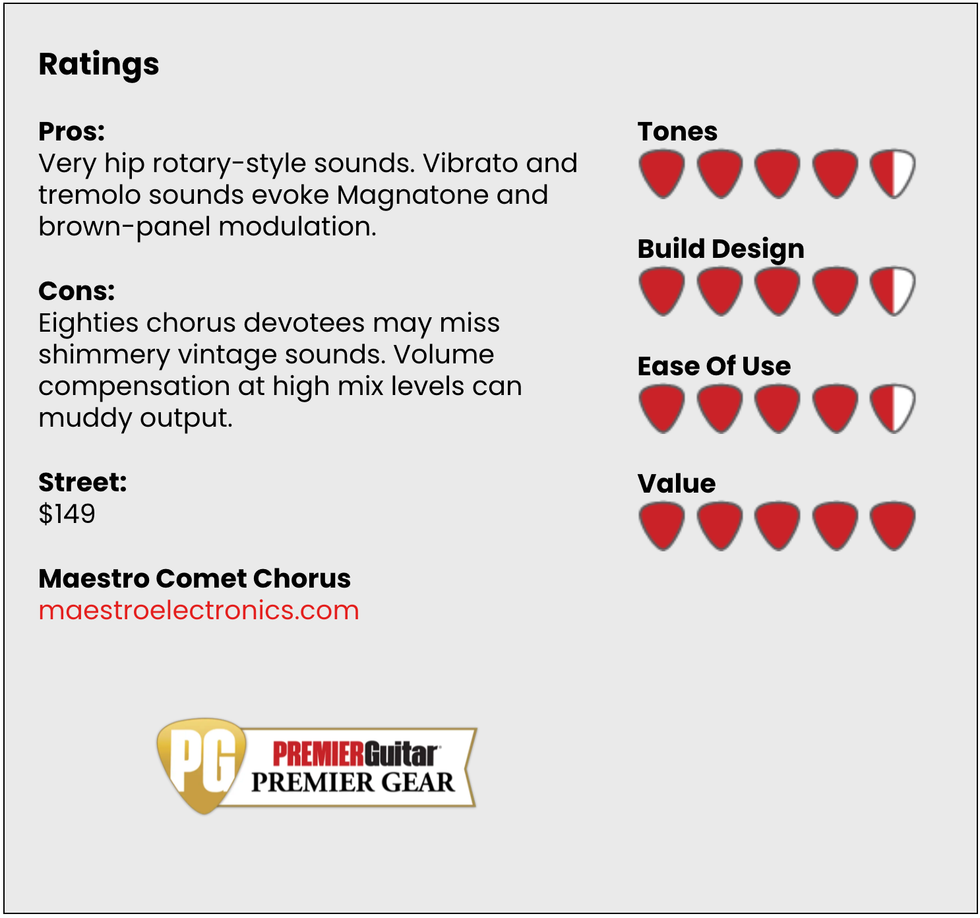
For more information about the Maestro pedal line, go to maestroelectronics.com.
Most good chorus pedals can generate a reasonable facsimile of a rotary speaker sound. The Comet Chorus, however, makes deep, rotary-like modulations the foundation of its voice. While you can generate ’70s- and ’80s-style chorus textures, there aren’t a wealth of tones here that match the liquid shimmer you associate with Roland, Boss, Ibanez, or EHX analog chorus from that era. Where the signature sounds of those units are distinguished, in part, by high harmonics that suggest ringing octave and unison strings from a 12-string, the Comet’s modulations have less sheen and excitability in the high frequencies—producing darker, pulsing, and arguably more mysterious chorus tones that evoke a Leslie or Fender Vibratone.
These modulations are an exciting alternative to canonical ’70s and ’80s chorus tones. But a lot of the Comet’s magic is its capacity to mix rotary-style sounds and vintage bucket brigade chorus to relatively unique ends. The Comet’s versatility even extends to generating cool vibrato tones at high mix and depth levels. And while I couldn’t match the queasiest, most intense textures of a dedicated vibrato unit, like a Boss VB-2, the Comet can sound like a cross between a dark vibrato and a Vibratone rotary speaker—a composite that, like actual rotary/chorus blends, can be mesmerizing.
One interesting facet of the Comet’s voice is the way that it thickens your tone and seems to add volume as you advance the mix. This can mean less defined modulations if you situate a gain source upstream. But the syrupy-thick modulations that result can sound awesome in a spare mix.
The Comet’s coolest feature might be its “orbit” mode, which adds tremolo to the already rich modulations. At modest depth and mix settings, the tremolo lends subtle complexity to the modulation waves. But at higher settings there’s more than a hint of an old Magnatone or Fender brown-panel amp’s throbby pitch wobble—sounds that lend greasy attitude to simple chord arpeggios and sass to soulful chord melodies and leads.
The Comet Chorus is a really lovely modulator—largely because it’s able to occupy unusual spaces that mix and bridge vibrato, chorus, and rotary speaker tones. Users hell-bent on nailing vintage-’80s chorus tones down to the letter may come away disappointed. For everyone else, there are a wealth of cool, even unusual modulation tones to mess with.
Invader Distortion
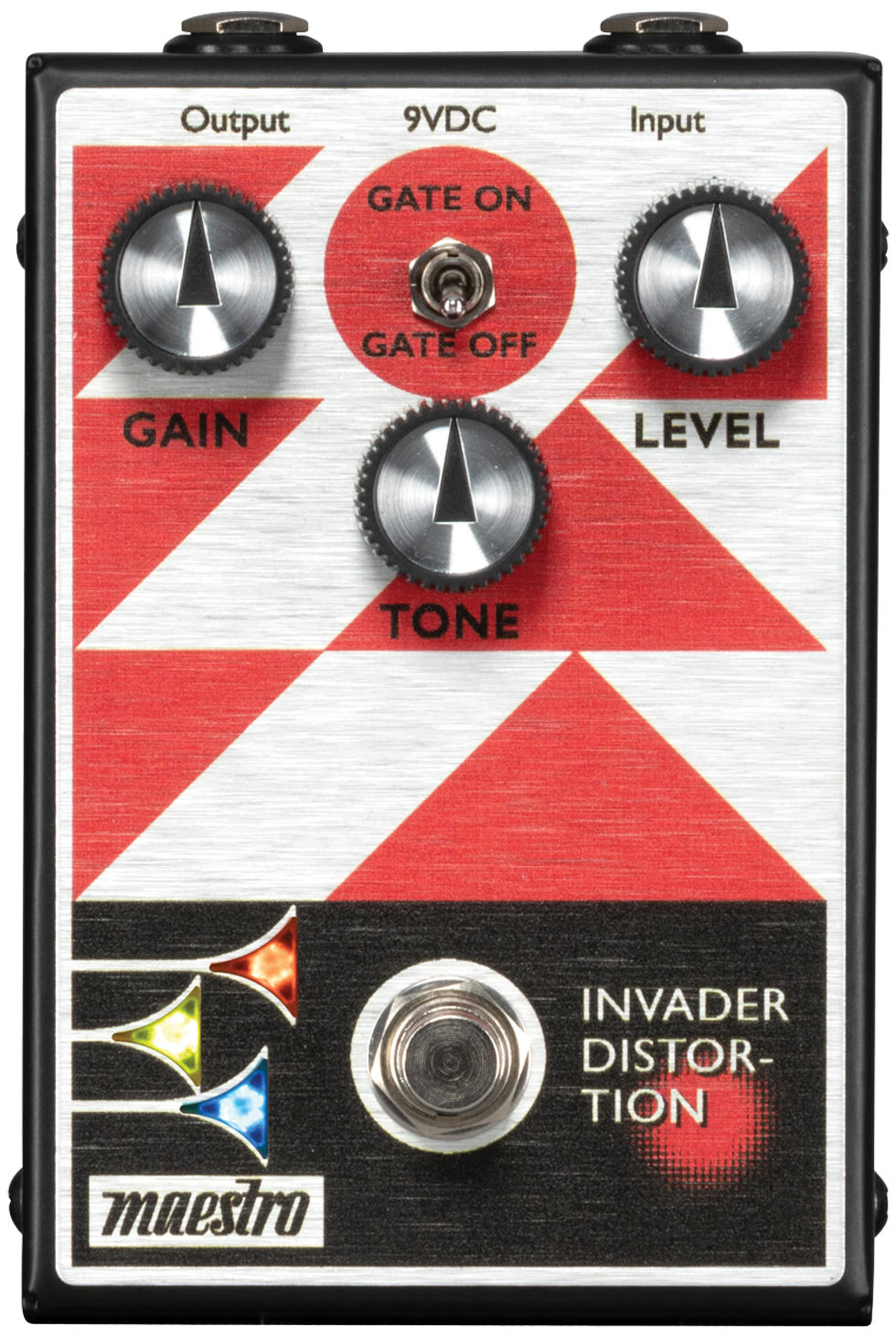
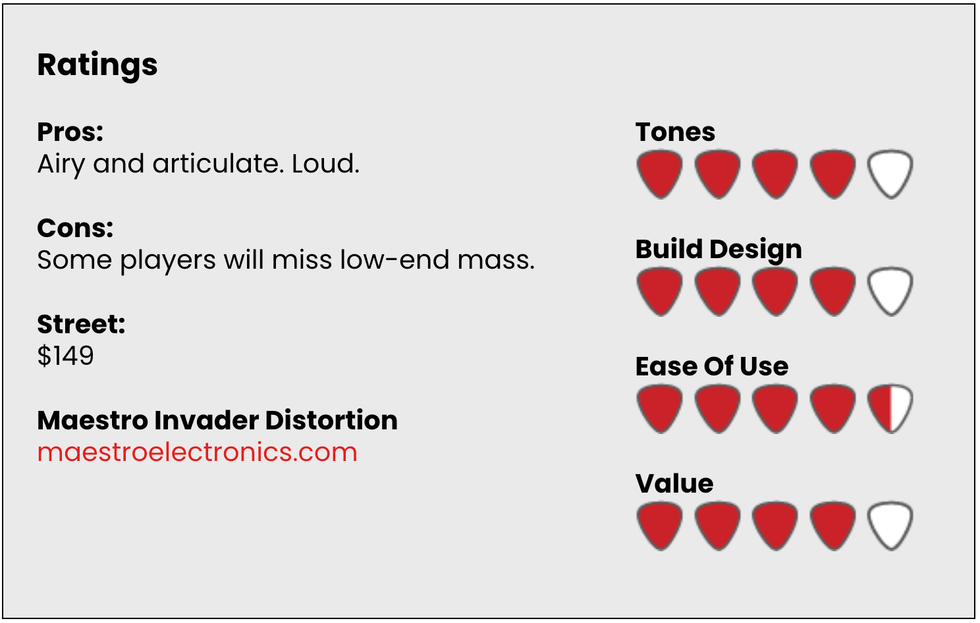
For more information about the Maestro pedal line, go to maestroelectronics.com.
While arguments over overdrives and fuzz inspire no end of vitriol among guitarists, distortion pedals—in strange inverse proportion to their aggressiveness—don’t seem to ignite the same feistiness amongst their proponents. Maybe that’s because almost any half-decent distortion pedal has the potential to transform the simplest riff into a Sunset Strip smash and unleash your inner animal. And if you’re in the right mood, they’re all pretty fun! The Maestro Invader excels at delivering such thrills. But it also offers a spacious voice that leaves lots of room for detail and quick-picking nuance. It’s no less rowdy than any of the classic distortions, but it tends to color your guitar’s sound much less and, in some cases, lets your amp breathe a lot more.
I don’t own a raft of distortion pedals, but I was able to run the Invader alongside a few classics. Compared to an ancient RAT2, the Invader was much brighter and sounded a lot less compressed. Alongside a Boss DS-1, it sounded airier, fuller, and less raspy. A battered MXR Distortion+ was perhaps the closet match, but still didn’t sound quite as open or detailed as the Invader. Part of the perceived (and very relative) clarity in the Invader is down to its inherent brightness and presence, which it mostly achieves without sounding shrill. There’s also the copious headroom. The Invader is loud—it’s little wonder why Maestro included a noise gate switch—so you can be very surgical and selective about how much distortion and bite you want to add on top.
The merits of these attributes are subjective, of course. I love the woof, compression, and darker capabilities of the RAT2, for instance. And even at its bassiest settings the Invader can’t deliver that pedal’s mysterious, cloudy sense of mass. For some players, though, the Invader will represent an ideal counterpoint to those hazier distortion tones. If you crave note articulation, massive volume, and the capacity to rise above a thick mix, the Invader is a distinctive sounding distortion alternative.
Discoverer Delay
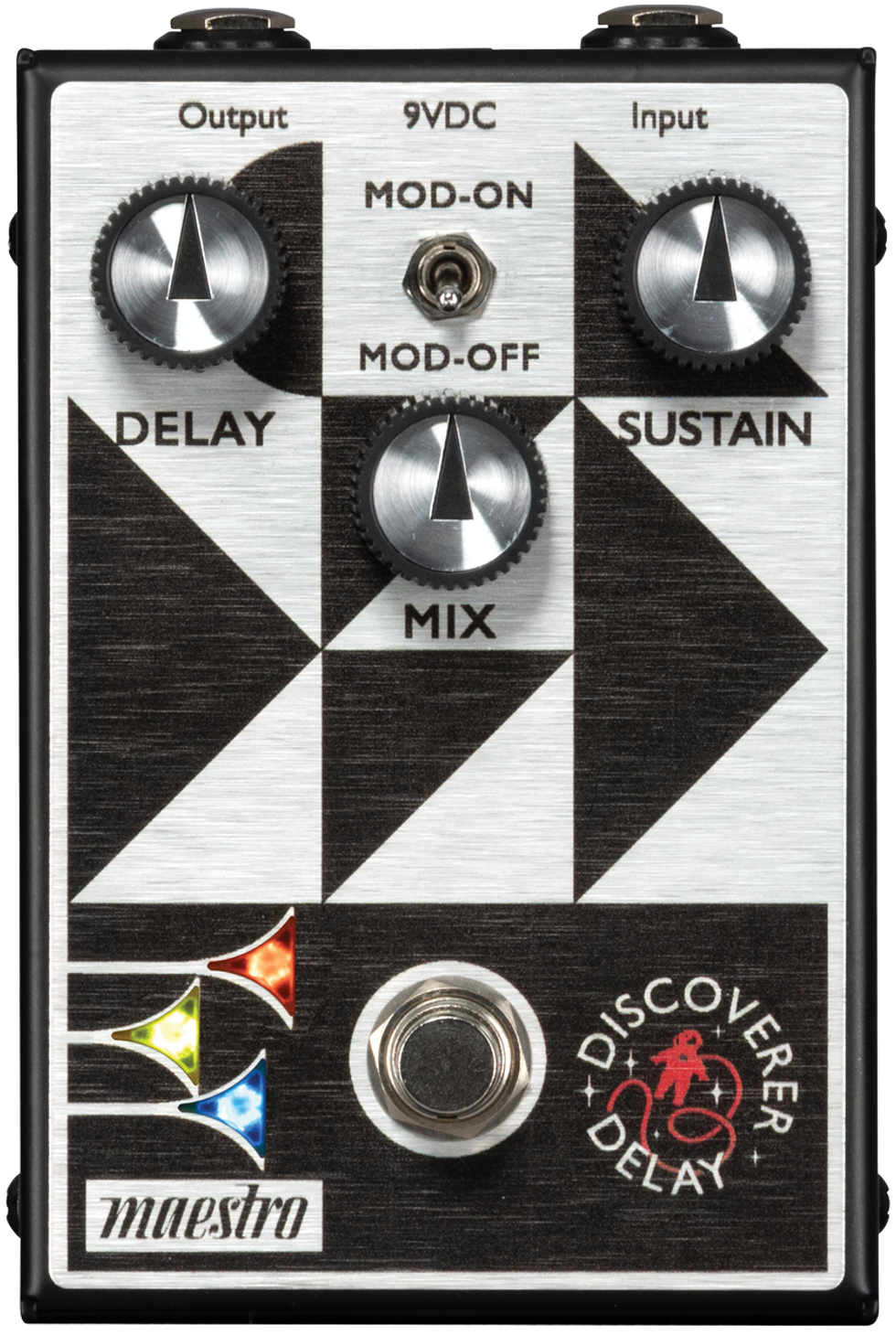
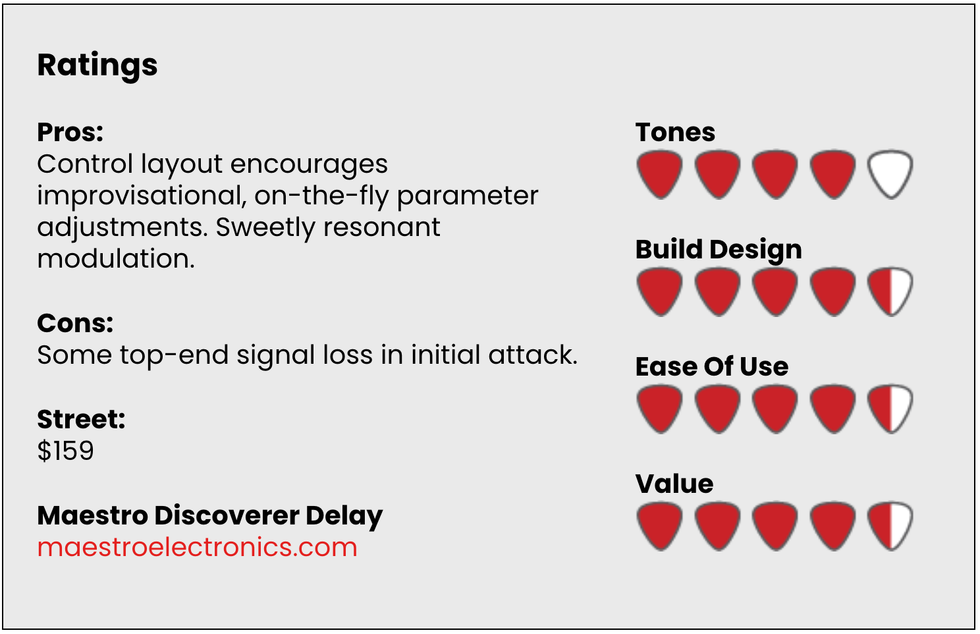
For more information about the Maestro pedal line, go to maestroelectronics.com.
Bucket brigade delay, like copious heaps of butter, tends to make everything more delicious. So it goes with the Discoverer Delay. Fundamentally, there isn’t a ton of difference between the voice of the Discoverer and other affordable bucket brigade delays like the MXR Carbon Copy and the Ibanez Analog Delay Mini. Like those pedals, it tops out at about 600 milliseconds of delay, and a bit of clock noise is almost always present in the repeats. The Discoverer’s repeats, however, are ever-so-slightly darker and hazier than the echoes from those units. The Discover also colors the attack of an initial note in a similar way. Depending on your tastes and objectives, these are not bad, and among the attributes that draw players to bucket brigade delay in the first place.
What really distinguishes the Discoverer is its modulation. Not coincidentally, perhaps, the modulation in the Discoverer has a bit in common with the vibrato sounds in the Comet Chorus. As a result, the Discoverer’s basic architecture and functionality starts to look and sound a lot like an old EHX Deluxe Memory Man. But there are subtle differences between the modulation in the two. The DMM’s vibrato modulations, at least on my vintage unit, have a very trebly and squiggly quality. The Discoverer’s, by contrast, are throatier, smoother, and more present in the low-midrange, as well as a tiny bit faster, giving the Discoverer’s modulations a more rotary-speaker-like voice. The results are intoxicating and addictive, to say the least.
Old-school Deluxe Memory Man users that creatively utilize the scale and spacing of the original DMM’s controls for oscillation and pitch-shift effects will also be thrilled with how the Explorer’s layout facilitates many of the same moves. All three knobs can be adjusted simultaneously with an easy three-finger grip, and the knobs turn with a smooth resistance that makes fluid, improvisational moves a piece of cake.
Ranger Overdrive
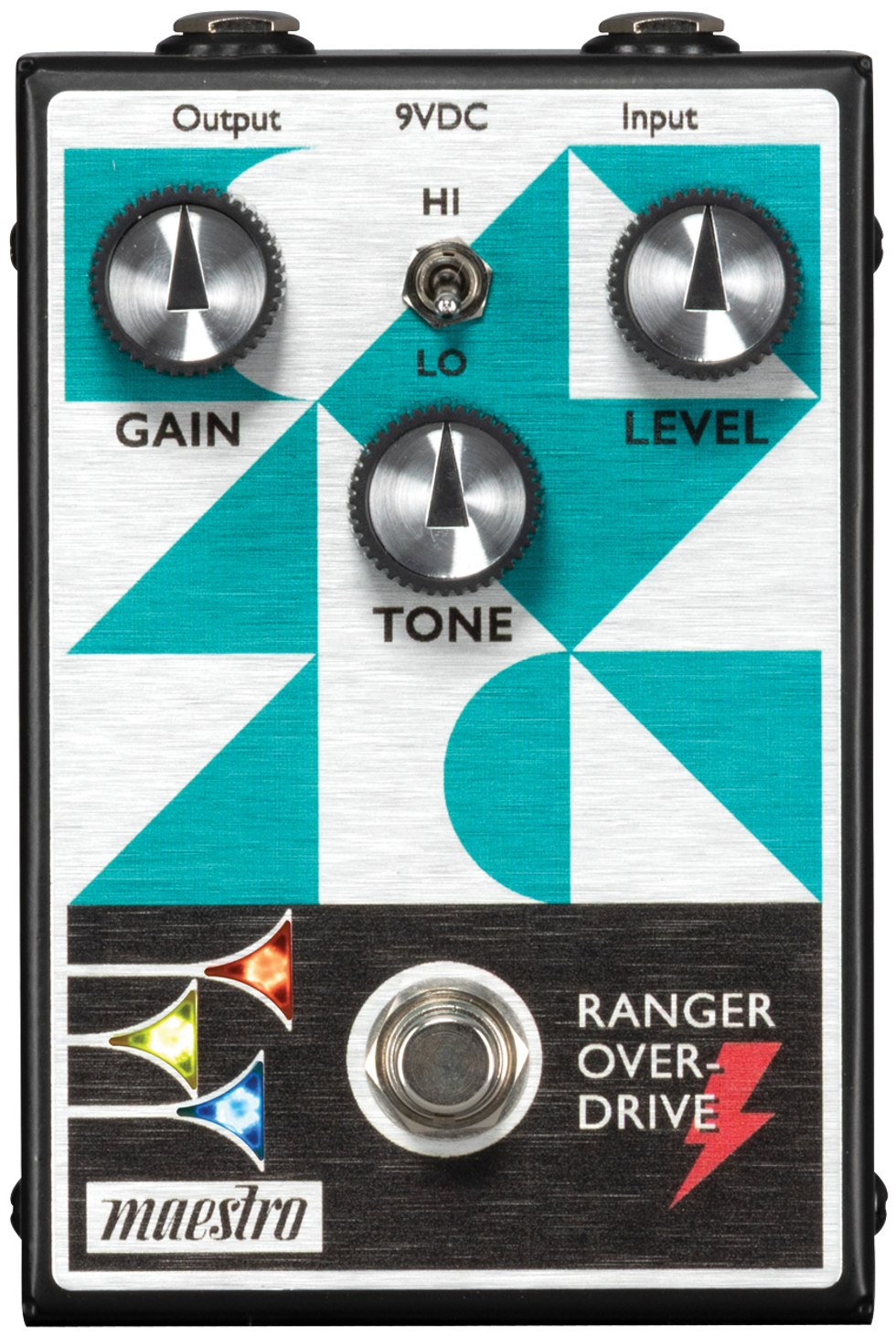
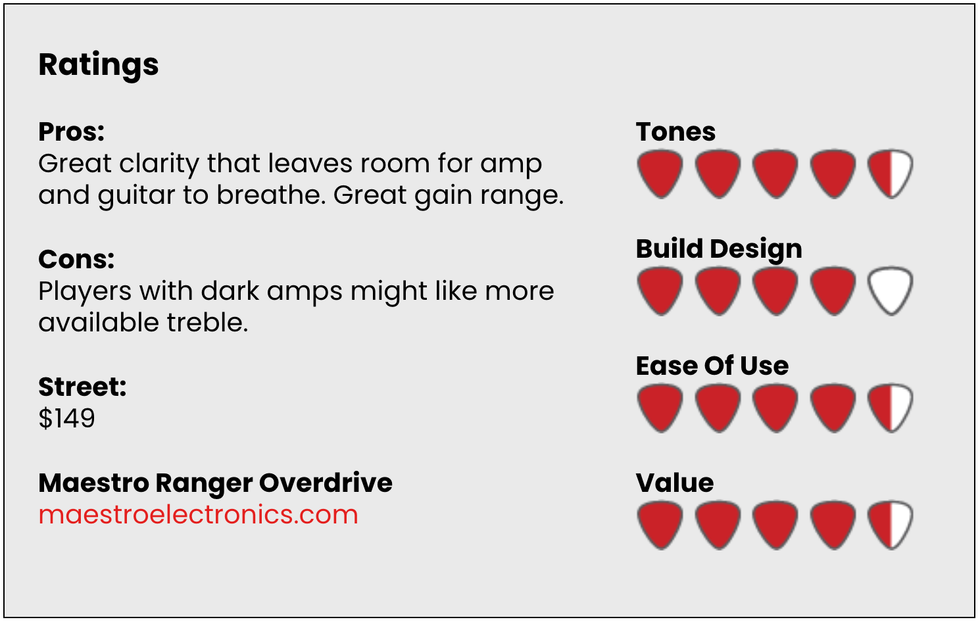
For more information about the Maestro pedal line, go to maestroelectronics.com.
Carving out unique sounds isn’t easy in the overdrive realm. Even among very different overdrive pedals, you’ll often find a loss of audible crossover in tonality—particularly when you add additional pedals to the mix. And because Maestro has thus far been pretty secretive about what goes on under the hood, it’s hard to say which overdrive circuit, if any, inspired this design. To my ear, however, the basic voice aligns closely in both sound and feel with that of the Klon Centaur and better Klon clones. Maestro highlights the Ranger’s blend of clean and distorted tones as a feature. This is, of course, a hallmark of Klon design, which blends an op-amp distorted signal path with second and third paths of undistorted lows and boosted near-clean sounds, then blends the dirty and clean paths via the gain knob.
Like a Klon, there is a basic high-fidelity feel to the Ranger. And compared to a vintage TS9 or a Boss SD-1, the Ranger is discernibly more oxygenated and open-sounding in many of the same ways that distinguish a Klon from those pedals. There are still obvious differences in the performance envelope of the Ranger and the Klon-type pedals I used for comparison. The EHX Soul Food and Tone Bakery Creme Brulee I used as Klon stand-ins (the latter was a near dead-ringer for the real thing in a shootout) both have more available treble than the Ranger. But this could be a good thing if you’re trying to tame spiky transients in your overdriven signal without sounding overly compressed. And, in general, the Ranger’s not-too-bright voice makes it a great partner for stacking with fuzz and other overdrives, and tends to color your amp and guitar voice a lot less.


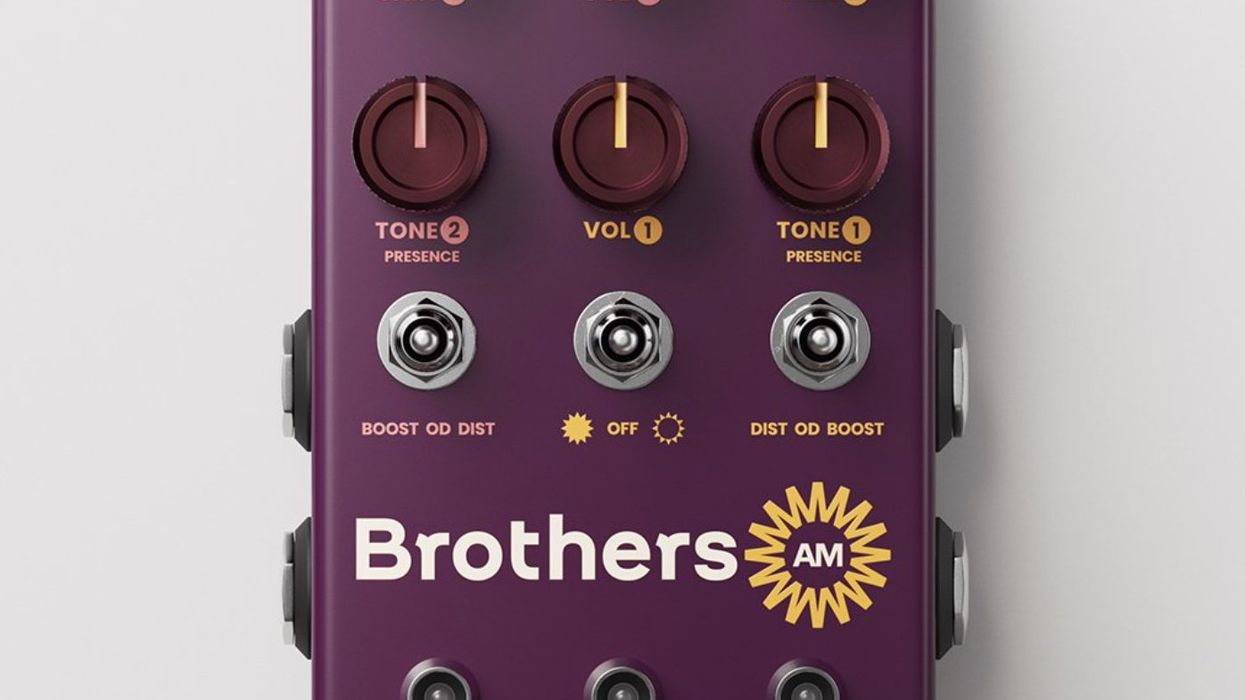
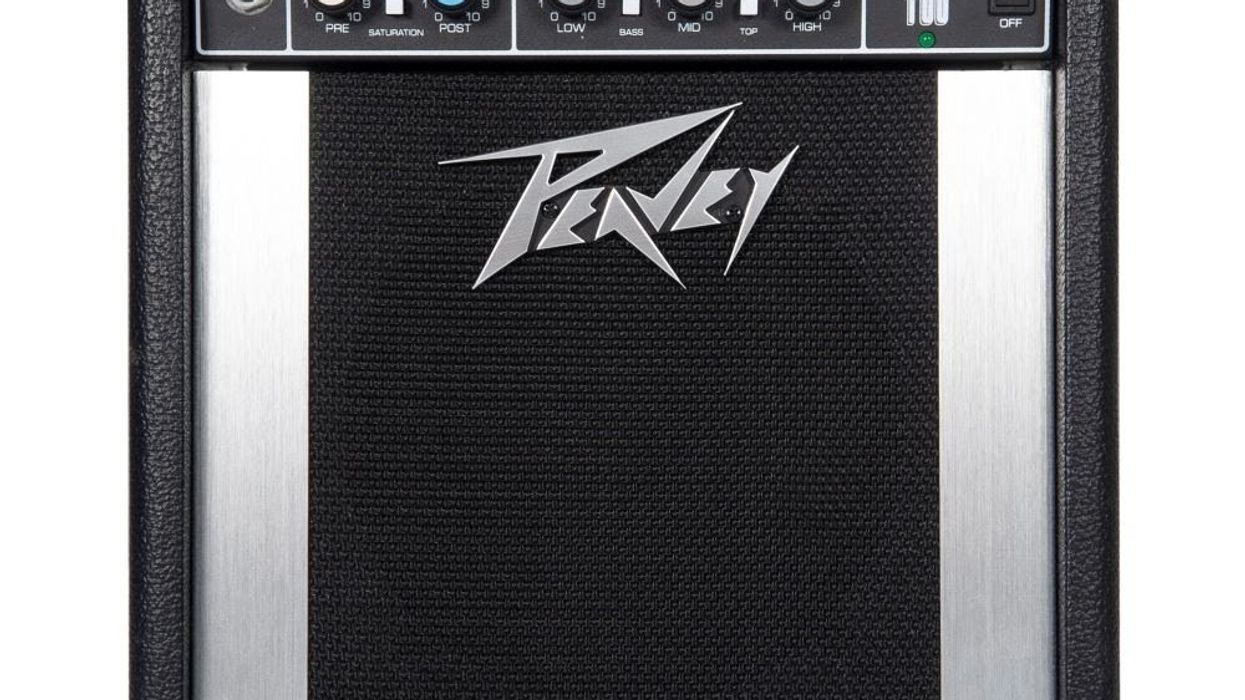
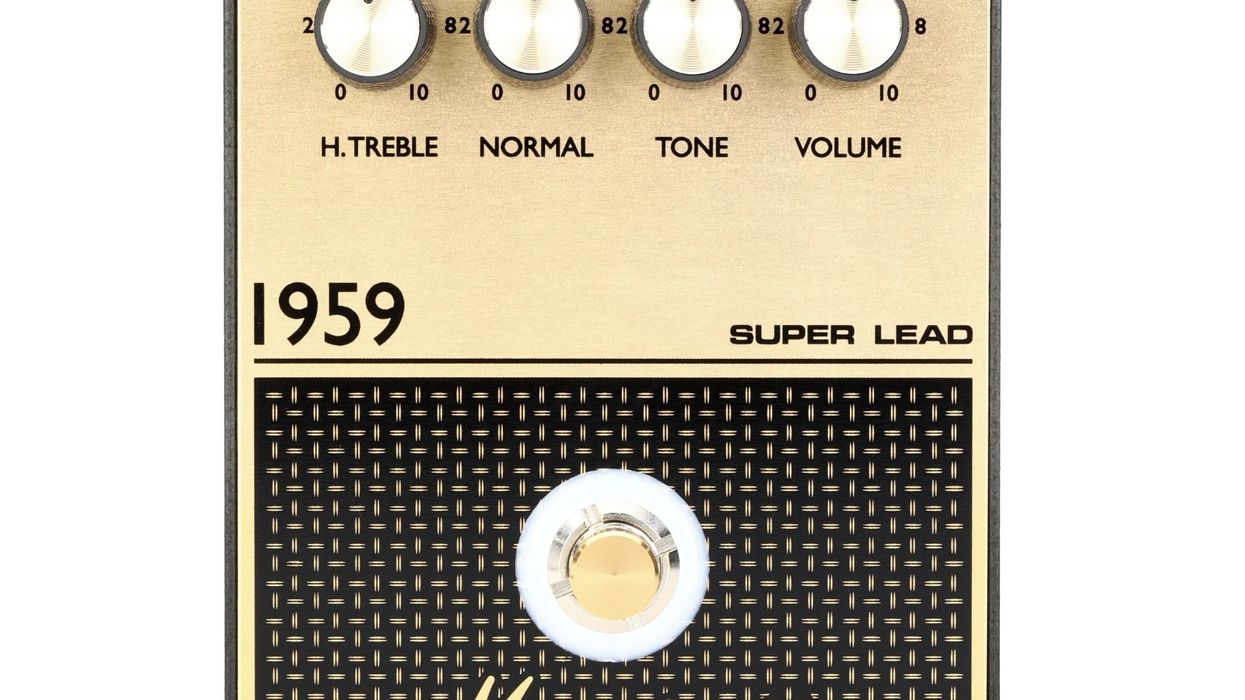







![Devon Eisenbarger [Katy Perry] Rig Rundown](https://www.premierguitar.com/media-library/youtube.jpg?id=61774583&width=1245&height=700&quality=70&coordinates=0%2C0%2C0%2C0)



